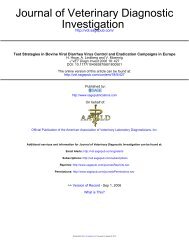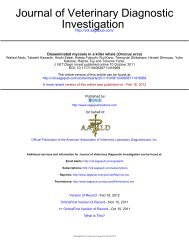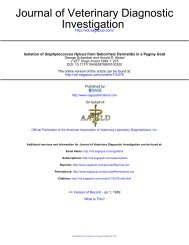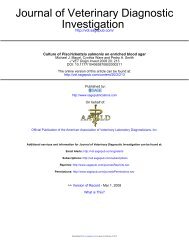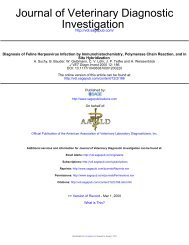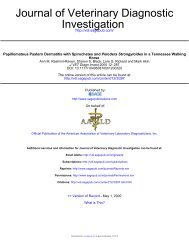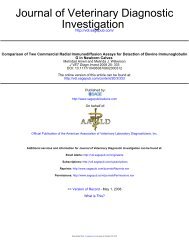Disseminated coccidiosis in short-beaked echidnas (Tachyglossus ...
Disseminated coccidiosis in short-beaked echidnas (Tachyglossus ...
Disseminated coccidiosis in short-beaked echidnas (Tachyglossus ...
Create successful ePaper yourself
Turn your PDF publications into a flip-book with our unique Google optimized e-Paper software.
Brief communications 483<br />
Figure 5. Bear liver reacted with Sarcocystis cruzi antisera. A. Overview show<strong>in</strong>g wide distribution of positively sta<strong>in</strong>ed organisms<br />
(arrows). 30 x . B. Discrete and <strong>in</strong>tensely sta<strong>in</strong>ed organisms (arrows). 150 x .<br />
2. Dubey JP, Duncan DE, Speer CA, Brown C: 1992, Congenital<br />
sarcocystosis <strong>in</strong> a two-day-old dog. J Vet Diagn Invest 4:89-93.<br />
3. Dubey JP, Speer CA: 1991, Sarcocystis canis n. sp. (Apicomplexa:<br />
Sarcocystidae), the etiologic agent of generalized <strong>coccidiosis</strong><br />
<strong>in</strong> dogs. J Parasitol 77:522-527.<br />
4. Dubey JP, Speer CA, Fayer R: 1989, Sarcocystosis of animals<br />
and man. CRC Press, Boca Raton, FL.<br />
5. L<strong>in</strong>dsay DS, Dubey JP: 1989, Immunohistochemical diagnosis<br />
J Vet Diagn Invest 5:483-488 (1993)<br />
of Neospora can<strong>in</strong>um <strong>in</strong> tissue sections. Am J Vet Res 50: 198 l-<br />
1983.<br />
6. Mense MG, Dubey JP, Homer BL: 1992, Acute hepatic necrosis<br />
associated with a Sarcocystis-like protozoa <strong>in</strong> a sea lion<br />
(Zalophus californianus). J Vet Diagn Invest 4:486490.<br />
7. Rakich PM, Dubey JP: 1992, Acute hepatic sarcocystosis <strong>in</strong> a<br />
ch<strong>in</strong>chilla. J Vet Diagn Invest 4:484-486.<br />
<strong>Dissem<strong>in</strong>ated</strong> <strong>coccidiosis</strong> <strong>in</strong> <strong>short</strong>-<strong>beaked</strong> <strong>echidnas</strong><br />
(<strong>Tachyglossus</strong> aculeatus) from Australia<br />
The <strong>short</strong>-<strong>beaked</strong> echidna (<strong>Tachyglossus</strong> aculeatus) is a<br />
sp<strong>in</strong>y-coated egg-lay<strong>in</strong>g mammal belong<strong>in</strong>g to the order<br />
J. P. Dubey, W. J. Hartley<br />
Monotremata and is naturally found only <strong>in</strong> Australia and<br />
New Gu<strong>in</strong>ea. It feeds almost entirely on ants and termites.<br />
Little is known of the diseases of <strong>echidnas</strong>, but <strong>in</strong>test<strong>in</strong>al<br />
<strong>coccidiosis</strong> is considered common. 1,5<br />
The echidna case materials were from the native fauna<br />
From the Zoonotic Diseases Laboratory, Livestock and Poultry<br />
Sciences Institute, BARC-East, ARS, USDA, Beltsville, MD 20705-<br />
2350 (Dubey), and the Taronga Zoo, PO Box 20, Mosman, New pathology register ma<strong>in</strong>ta<strong>in</strong>ed at the Taronga Zoo <strong>in</strong> Sydney,<br />
South Wales 2088, Australia (Hartley).<br />
Australia. Case nos. 1, 3, and 5 came from the Melbourne<br />
Received for publication October 28, 1992. Zoo, and case nos. 2 and 4 were from the Sydney Zoo col-
484<br />
Brief communications<br />
Table 1. Summary of exam<strong>in</strong>ation of tissues* from <strong>echidnas</strong> with protozoal lesions.
Brief communications 485<br />
Figures 6-10. Sections of the liver of naturally <strong>in</strong>fected <strong>echidnas</strong>. HE, 750 x .6. Echidna no. 1. Focus of hepatic necrosis and mononuclear<br />
cell <strong>in</strong>filtration and a schizont with a residual body (arrow). 7. Echidna no. 1. Three merozoites <strong>in</strong> a vacuole. Note the size and shape of<br />
merozoites is dist<strong>in</strong>ct from the schizont <strong>in</strong> Fig. 6. The hepatocytes are vacuolated. 8. Echidna no. 5. A collection of 5 protozoan bodies<br />
with nuclei (arrowheads) separated by septa. Whether these protozoa are develop<strong>in</strong>g microgamont or schizont could not be determ<strong>in</strong>ed.<br />
9. Echidna no. 5. A microgamont (arrow) with slender microgametes (arrowheads). 10. Echidna no. 5. A granuloma with an oocyst <strong>in</strong> the<br />
center of the lesion. Note the oocyst wall (arrowheads) and the central nucleus (arrow).<br />
lections (Table 1). Only paraff<strong>in</strong>-embedded 5-6-µm-thick Neospora can<strong>in</strong>um, and Sarcocystis cruzi us<strong>in</strong>g the techhistologic<br />
sections were available for this study. Sections were niques and reagents described previously. 4<br />
<strong>in</strong>itially exam<strong>in</strong>ed after sta<strong>in</strong><strong>in</strong>g with hematoxyl<strong>in</strong> and eos<strong>in</strong> Lesions were most severe <strong>in</strong> echidna no. 1 and were present<br />
(HE). Selected sections were sta<strong>in</strong>ed with periodic acid-Schiff <strong>in</strong> the lung, liver, kidneys, heart, and spleen. Pneumonia was<br />
hematoxyl<strong>in</strong> (PASH) or with antisera to Toxoplasma gondii, characterized by diffuse mixed mononuclear cell <strong>in</strong>terstitial<br />
Figures 1-5. Sections of lungs of naturally <strong>in</strong>fected <strong>echidnas</strong>. HE. 1. Echidna no. 1. Longitud<strong>in</strong>ally cut artery with strands of fibr<strong>in</strong> and<br />
blood elements. Two schizonts (arrowheads) are visible <strong>in</strong> the endothelium. 150 x . 2. Higher magnification of the artery <strong>in</strong> Fig. 1 show<strong>in</strong>g<br />
2 immature schizonts (arrows) <strong>in</strong> the endothelium and several free merozoites (arrowheads) <strong>in</strong> the lumen. 750 x . 3. Echidna no. 1. Two<br />
groups of merozoites (arrowheads) <strong>in</strong> the <strong>in</strong>terstitium. 1,500 x . 4. Echidna no. 1. A schizont <strong>in</strong> the alveolar <strong>in</strong>terstitium show<strong>in</strong>g a central<br />
residual body (arrow) and slender merozoites (arrowheads). Compare the structure of the merozoites that of merozoites <strong>in</strong> Fig. 2. 1,500 x .<br />
5. Echidna no. 2. An oocyst with central nucleus (arrow) <strong>in</strong> the alveolus. 750 x.
486 Brief communications<br />
Figures 11-15. Sections of tissues of naturally <strong>in</strong>fected <strong>echidnas</strong>. HE. 11. Heart of echidna no. 1, show<strong>in</strong>g an <strong>in</strong>flammatory focus and<br />
a schizont (arrow) <strong>in</strong> a capillary. 150 x . 12. Higher magnification of the capillary with schizont <strong>in</strong> Fig. 11. Perivascular <strong>in</strong>filtration of<br />
mononuclear cells and a schizont (arrow). 750 x . 13. Kidney of echidna no. 1, with glomerulonephritis <strong>in</strong> cortex and a necrotic focus on<br />
the left. 150 x. 14, 15. Spleen of echidna no. 5, show<strong>in</strong>g 2 schizonts (arrows) with structurally dist<strong>in</strong>ct merozoites. 1,500 x.<br />
<strong>in</strong>flammation, associated with protozoa, Protozoa were seen<br />
<strong>in</strong> the venules, capillaries, large blood vessels, and the <strong>in</strong>terstitium<br />
(Figs. 1-4). Protozoa divided by schizogony. Immature<br />
and mature schizonts and free merozoites were seen<br />
<strong>in</strong> the endothelium of large blood vessels and <strong>in</strong> unidentified<br />
cells <strong>in</strong> the vascular lum<strong>in</strong>a (Fig. 2). Schizonts were up to 20<br />
x 15 µm and conta<strong>in</strong>ed up to 16 merozoites, sometimes<br />
around a central residual body (Fig. 4). Merozoites <strong>in</strong> some<br />
schizonts were slender (< 1 µm thick), whereas others were<br />
up to 2 µm thick (Figs. 3, 4). Schizonts and merozoites were<br />
PAS negative. Similar but milder lesions with fewer parasites<br />
were seen <strong>in</strong> the lungs of echidna nos. 2 and 3. In echidna<br />
no. 2, 3 unsporulated oocysts were seen <strong>in</strong> separate alveoli<br />
(Fig. 5).<br />
Hepatitis was seen <strong>in</strong> echidna nos. 1, 3, and 5. In echidna<br />
no. 1, the hepatic lesions consisted of generalized portal tract<br />
mixed mononuclear cell <strong>in</strong>filtration extend<strong>in</strong>g <strong>in</strong>to hepatic<br />
cords. Other changes were bile ductule proliferation, mild<br />
bile stasis, and mild recent fibr<strong>in</strong>ous perihepatitis (Fig. 6).<br />
Relatively few schizonts were seen (Figs. 6, 7). Similar but<br />
milder lesions were seen <strong>in</strong> echidna nos. 3 and 5. In addition<br />
to the type of lesions <strong>in</strong> echidna no. 1, granulomas were<br />
scattered throughout the liver <strong>in</strong> echidna no. 5. Schizonts,<br />
zoites, gamonts and oocysts were associated with these granulomas<br />
(Figs. 8-10). Schizonts were up to 15 µm <strong>in</strong> diameter<br />
and conta<strong>in</strong>ed slender merozoites. There were also collections<br />
of 1 or 2 zoites with thickness up to 3 µm; these zoites<br />
conta<strong>in</strong>ed PASH-positive granules. One mature 33- x 32pm<br />
male (micro) gamont with slender microgametes is shown<br />
<strong>in</strong> Fig. 9. There were several unsporulated oocysts up to 25
Brief communications 487<br />
Figures 16-20. Sections of <strong>in</strong>test<strong>in</strong>es of <strong>echidnas</strong> naturally <strong>in</strong>fected with coccidia. HE. 16. Echidna no. 5. Gamonts <strong>in</strong> epithelial cells<br />
l<strong>in</strong><strong>in</strong>g the glands of Lieberkiihn and the surface epithelium. Arrow po<strong>in</strong>ts to an <strong>in</strong>fected gland near the muscularis mucosae. 75 x. 17.<br />
Echidna no. 2. A schizont <strong>in</strong> the lam<strong>in</strong>a propria with numerous t<strong>in</strong>y merozoites (arrow). Note several develop<strong>in</strong>g macrogametes (arrowheads)<br />
<strong>in</strong> the surface epithelial cells. 750 x . 18. Echidna no. 2. A mature microgamont with a central residual body (arrow) and microgametes <strong>in</strong><br />
surface epithelium. Two macrogametes (arrowheads) are also present. 19. Echidna no. 4. Two oocysts (arrows) <strong>in</strong> surface epithelial cells.<br />
20. Echidna no. 5. Two oocysts (arrow) <strong>in</strong> the surface epithelial cells. 750 x .<br />
µm <strong>in</strong> diameter. One oocyst with a nucleus and oocyst walls cell <strong>in</strong>terstitial <strong>in</strong>flammation (Fig. 13). Many glomeruli apis<br />
shown <strong>in</strong> Fig. 10. There were other oocyst-size empty peared enlarged and hypercellular. Some had adhesions bespaces,<br />
suggest<strong>in</strong>g the destruction of oocysts by granuloma- tween the visceral and parietal layers of Bowman’s capsule.<br />
tous host response. There were also immature microgamont- A few had erythrocytes <strong>in</strong> Bowman’s capsule, and others<br />
like unidentified structures. conta<strong>in</strong>ed a few to many granulocytes. Many cortical tubules<br />
Myocarditis was seen only <strong>in</strong> echidna no. 1 and was char- were distended with granulocytes and conta<strong>in</strong>ed erythroacterized<br />
by a moderately severe mixed mononuclear cell cytes, hemoglob<strong>in</strong>, and/or other blood pigments. Some medgranulocytic<br />
<strong>in</strong>terstitial <strong>in</strong>flammation. One large focus of ullary collect<strong>in</strong>g tubules conta<strong>in</strong>ed erythrocytes and blood<br />
subendocardial myonecrosis with surround<strong>in</strong>g <strong>in</strong>flammatory pigments. Numerous glomerular capillary tufts conta<strong>in</strong>ed 1<br />
response is shown <strong>in</strong> Fig. 11. Schizonts were seen associated and occasionally 2 schizonts. Schizonts were occasionally<br />
with lesions (Fig. 12). seen <strong>in</strong> extraglomerular tissue.<br />
Renal lesions were seen <strong>in</strong> echidna nos. 1 and 3 and con- Splenitis was seen <strong>in</strong> echidna no. 1 and consisted of a<br />
sisted of moderate, focal dissem<strong>in</strong>ated mixed mononuclear massive, almost complete multifocal recent non<strong>in</strong>flamma-
488 Brief communications<br />
tory parenchymal necrosis and lysis associated with groups<br />
of bacteria (probably secondary <strong>in</strong>fection), with focal hemorrhages.<br />
Structurally dist<strong>in</strong>ct types of schizonts with slender<br />
merozoites (Fig. 14) or <strong>short</strong> stubby merozoites (Fig. 15) were<br />
seen.<br />
Intest<strong>in</strong>al <strong>coccidiosis</strong> was seen <strong>in</strong> echidna nos. 2, 4, and 5<br />
(Figs. 16-20). Lesions were more severe <strong>in</strong> the small <strong>in</strong>test<strong>in</strong>es<br />
of echidna nos. 2 and 5 and consisted of desquamation<br />
of epithelial cells of glands of Lieberkiihn and surface epithelium,<br />
hypertrophy of villous epithelium, and mononucle-<br />
ar cell <strong>in</strong>filtration <strong>in</strong> lam<strong>in</strong>a propria. Gamonts and oocysts<br />
were seen <strong>in</strong> all 3 <strong>echidnas</strong>.<br />
Oocysts were approximately 25 x 20 µm and were unsporulated<br />
(Figs. 18-20). Few schizonts were seen only <strong>in</strong> 1.<br />
echidna no. 2. A 45- x 25-µm schizont with numerous t<strong>in</strong>y<br />
merozoites <strong>in</strong> the lam<strong>in</strong>a propria of the small <strong>in</strong>test<strong>in</strong>e is<br />
shown <strong>in</strong> Fig. 17.<br />
Protozoa <strong>in</strong> the lung and liver of echidna no. 1 did not 2.<br />
react to T. gondii, N, can<strong>in</strong>um, or S. cruzi antisera.<br />
Protozoa <strong>in</strong> extra<strong>in</strong>test<strong>in</strong>al tissues of <strong>echidnas</strong> were un- 3 =<br />
J Vet Diagn Invest 5:488-494 (1993)<br />
The <strong>in</strong>travascular schizonts <strong>in</strong> the lungs of the <strong>echidnas</strong><br />
were structurally similar to schizonts of Sarcocystis, particularly<br />
of the Sarcocystis species <strong>in</strong> cattle, sheep, and goats. 3<br />
Some of the schizonts <strong>in</strong> the liver, lungs, and spleen were<br />
difficult to dist<strong>in</strong>guish from tachyzoites of T. gondii. 2 However,<br />
T. gondii tachyzoites always divide <strong>in</strong>to 2 by endodyogeny,<br />
whereas the extra<strong>in</strong>test<strong>in</strong>al protozoa of the <strong>echidnas</strong><br />
divided <strong>in</strong>to many organisms by schizogony. 2<br />
Acknowledgements. We thank the staff of the Veter<strong>in</strong>ary<br />
Research Institute <strong>in</strong> Melbourne who made 3 of the cases<br />
available for exam<strong>in</strong>ation.<br />
References<br />
identified. Protozoa <strong>in</strong> the <strong>in</strong>test<strong>in</strong>es of <strong>echidnas</strong> <strong>in</strong> the pres-<br />
4.<br />
ent study appeared to be structurally similar to the <strong>in</strong>test<strong>in</strong>al<br />
coccidia of the <strong>echidnas</strong>. 1 Barker IK, Beveridge I, Munday BL: 1985, Coccidia (Eimeria<br />
tachyglossi) n. sp., E. echidnae n. sp., and Octosporella hystrix n.<br />
sp.) <strong>in</strong> the echidna, TachygZossus aculeatus (Monotremata: Tachyglossidae).<br />
J Protozool 32:523-525.<br />
Dubey JP, Beattie CP: 1988, Toxoplasmosis ofanimals and man.<br />
CRC Press, Boca Raton, FL.<br />
Dubey JP, Speer CA, Fayer R: 1989, Sarcocystosis of animals<br />
and man. CRC Press, Boca Raton, FL.<br />
L<strong>in</strong>dsay DS, Dubey JP: 1989, Immunohistochemical diagnosis<br />
of Neospora can<strong>in</strong>um <strong>in</strong> tissue section of dogs. Am J Vet Res 50:<br />
Gamonts and oocysts <strong>in</strong> the liver 1981-1983.<br />
of echidna no. 5 and <strong>in</strong> the lungs of echidna no. 2 were 5 Whitt<strong>in</strong>gton RJ: 1988, The monotremes <strong>in</strong> health and disease<br />
structurally similar to <strong>in</strong>test<strong>in</strong>al gamonts and oocysts. How-<br />
l <strong>in</strong> Australian wildlife. Proc Postgrad Comm Vet Sci Univ Sydney,<br />
ever, it was not possible to l<strong>in</strong>k these extra<strong>in</strong>test<strong>in</strong>al stages pp. 727-787.<br />
because not all tissues were available from each echidna.<br />
Cycad (Zamia puertoriquensis) toxicosis <strong>in</strong> a group of<br />
dairy heifers <strong>in</strong> Puerto Rico<br />
Rachel Y. Reams, Evan B. Janovitz, Farrel R. Rob<strong>in</strong>son,<br />
John M. Sullivan, Carlos Rivera Casanova, Edw<strong>in</strong> Más<br />
Cycads are a group of palm-like plants <strong>in</strong> the family<br />
Cycadaceae 19 found <strong>in</strong> tropical and subtropical areas<br />
throughout the world. Cycads have been used for centuries<br />
for food and for decorative and medic<strong>in</strong>al purposes. Cycad<br />
toxicosis has been associated with <strong>in</strong>gestion of raw leaves<br />
and nuts and <strong>in</strong>adequately washed flour. 5,10,12-19 Cl<strong>in</strong>ical signs<br />
<strong>in</strong> humans are usually related to disturbances of the gastro<strong>in</strong>test<strong>in</strong>al<br />
tract, such as vomit<strong>in</strong>g, diarrhea, and colic 5,12 but<br />
coma and paralysis have also been reported. 19 Cycad toxicosis<br />
has been suspected as a cause of amyotrophic lateral<br />
sclerosis-park<strong>in</strong>sonism dementia (ALS-PD) <strong>in</strong> the western<br />
From the Indiana Animal Disease Diagnostic Laboratory and the<br />
Department of Veter<strong>in</strong>ary Pathobiology, Purdue University, West<br />
Lafayette, IN 47907 (Reams, Janovitz, Rob<strong>in</strong>son, Sullivan), the Manati<br />
Veter<strong>in</strong>ary Cl<strong>in</strong>ic, Manati, PR 00701 (Rivera Casanova), and<br />
the Department of Pasture Management, University of Mayaguez,<br />
Mayaguez, PR 00680 (Mas). Current address (Sullivan): Marion-<br />
Merrell Dow, PO Box 68740, Indianapolis, IN 46268-0470.<br />
Received for publication November 3, 1992.<br />
Pacific region, 18,19 although this association has been disputed.<br />
2-4<br />
Cycad toxicosis has been reported <strong>in</strong> livestock, primarily<br />
rum<strong>in</strong>ants. 5,6,10,11,15,16 Two dist<strong>in</strong>ct syndromes, neurologic and<br />
hepatic-gastro<strong>in</strong>test<strong>in</strong>al, 15 have been described <strong>in</strong> rum<strong>in</strong>ants.<br />
Rum<strong>in</strong>ants with the hepatic-gastro<strong>in</strong>test<strong>in</strong>al syndrome of<br />
cycad toxicosis were depressed and anorectic 10,16 and lost<br />
weight. 16 Necropsy f<strong>in</strong>d<strong>in</strong>gs <strong>in</strong>cluded cirrhosis, ascites, and<br />
hemorrhage and necrosis of the mucosa of the small <strong>in</strong>test<strong>in</strong>e<br />
and abomasum. 10,15 Microscopically, hepatocellular megalocytosis,<br />
periac<strong>in</strong>ar necrosis, fibrosis around central ve<strong>in</strong>s,<br />
cholestasis, and biliary duct hyperplasia were present. 10,15<br />
The neurologic syndrome of cycad toxicosis <strong>in</strong> cattle- has<br />
been called Zamia staggers. That syndrome is characterized<br />
cl<strong>in</strong>ically by weight loss followed by lateral sway<strong>in</strong>g of the<br />
h<strong>in</strong>d quarters, with weakness, ataxia and proprioceptive defects<br />
<strong>in</strong> the rear limbs. 6,11 Demyel<strong>in</strong>ation and axonal degeneration<br />
were present <strong>in</strong> the bra<strong>in</strong>, sp<strong>in</strong>al cord, and dorsal-root<br />
ganglia. 11 Surviv<strong>in</strong>g cattle rema<strong>in</strong>ed ataxic and-had secondary<br />
atrophy of the musculature of the h<strong>in</strong>d quarters. 6,11,15




